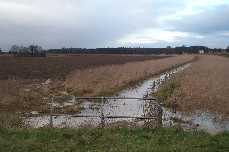ADAS Soil P index: A measure of the phosphorus (P)
content of soil. This is determined using the Olsen's P method.
| INDEX | Olsens P concentration
(mg/L) |
| 0 | 0-9 |
| 1 | 10-15 |
| 2 | 16-25 |
| 3 | 26-45 |
| 4 | 46-70 |
| 5 | 71-100 |
| 6 | 100-140 |
| 7 | 141-200 |
| 8 | 201-280 |
| 9 | over 280 |
 Diffuse
pollution: comprises contamination and pollution arising from many dispersed sources. Pollution can enter a river or lake at a single point, such as an effluent discharge pipe. A discharge like this is called a point source. However, pollutants can enter a river at many different places in a catchment, which cannot be identified individually. Examples of diffuse pollution sources are sheet run off from fields or seepage of nutrients from soil into ground water. Diffuse pollution can come from many different sources and sources are often individually minor, but collectively significant.
Information from DEFRA on diffuse pollution in agriculture can be found here. Diffuse
pollution: comprises contamination and pollution arising from many dispersed sources. Pollution can enter a river or lake at a single point, such as an effluent discharge pipe. A discharge like this is called a point source. However, pollutants can enter a river at many different places in a catchment, which cannot be identified individually. Examples of diffuse pollution sources are sheet run off from fields or seepage of nutrients from soil into ground water. Diffuse pollution can come from many different sources and sources are often individually minor, but collectively significant.
Information from DEFRA on diffuse pollution in agriculture can be found here.
Hydrological
connectivity: the linkage of areas through different hydrological flow paths
Phosphorus: Phosphorus (P) is a non-renewable resource and
biosolids have been used for many years as sources of P for agricultural crops.
 Nutrient: Essential elements required for life. The addition of sewage sludge to land increases the nutrient content of the soil, however if application levels are based upon nitrogen
concentration, this will result in excess phosphorus, as biosolids are enriched in the latter. Environmental concerns regarding nutrients arise
when they become available to aquatic organisms and could, in severe cases,
lead to freshwater eutrophication: algal blooms, excessive growth of aquatic
weeds, reduced water transparency and local fish kills due to deoxygenation. Nutrient: Essential elements required for life. The addition of sewage sludge to land increases the nutrient content of the soil, however if application levels are based upon nitrogen
concentration, this will result in excess phosphorus, as biosolids are enriched in the latter. Environmental concerns regarding nutrients arise
when they become available to aquatic organisms and could, in severe cases,
lead to freshwater eutrophication: algal blooms, excessive growth of aquatic
weeds, reduced water transparency and local fish kills due to deoxygenation.
Sewage
Sludge or Biosolids:
Sewage sludge is a by-product of sewage
treatment. Sewage sludge must be treated before it is used in
agriculture in order to reduce odour, volume and pathogen levels
| 




